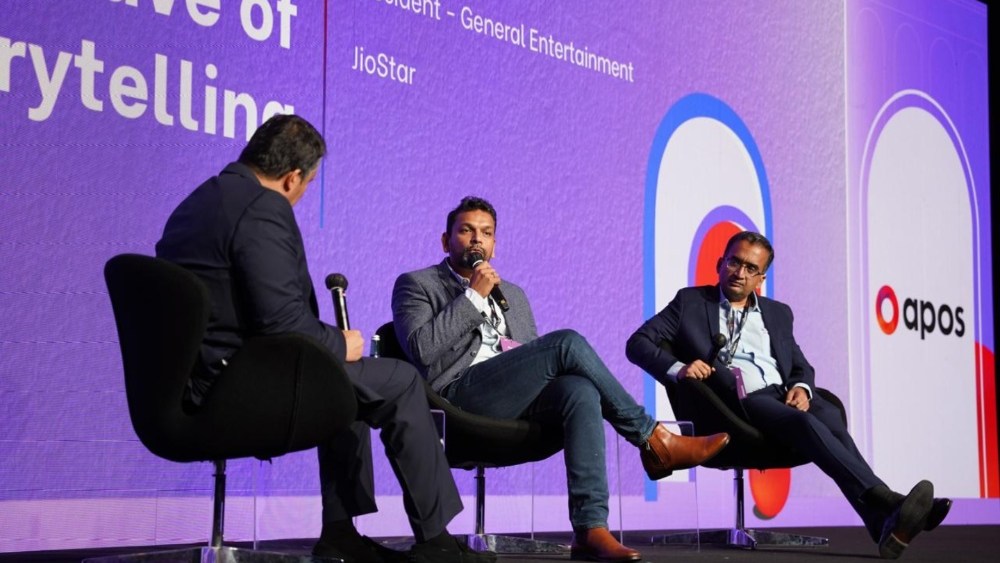Indian media giant JioStar is positioning itself as a collaborator rather than gatekeeper in India’s evolving content ecosystem, with executives outlining an ambitious vision for culturally rooted storytelling that serves the country’s massive youth demographic.
Speaking at the APOS conference in Indonesia, JioStar content chiefs Alok Jain and Krishnan Kutty detailed plans to dramatically scale programming for Gen Z audiences, particularly in South India, where they intend to increase volume by 7 to 10 times current levels.
“In a country as creatively diverse as India, it’s no longer about scaling content, it’s about resetting the creative ecosystem,” Jain said during a fireside session titled “Inside the Next Wave of Indian Storytelling.” “At JioStar, we’re committed to ensuring creators are not boxed in by platforms, formats, or legacy structures.”
The exec emphasized the company’s role as facilitator rather than traditional broadcaster. “Our role is not to act as gatekeepers, but as collaborators,” he said. “We’re building mechanisms that empower creators to move fluidly across mediums, with opportunities that evolve with their voice.”
Kutty, meanwhile, redefined what constitutes bold storytelling in the current landscape. “What was considered bold five or six years ago is not what’s considered bold now,” he explained. “Back then, it was about scale and visual spectacle. Today, boldness is about pushing societal norms, asking deeper questions, and doing it within the Indian context.”
The executive stressed the importance of cultural authenticity: “We’re not in California; we’re in India and we need to be rooted in our cultural values. Our job is to push boundaries, but also to carry our audience with us.”
JioStar’s approach comes as India’s entertainment industry grapples with evolving audience demands and economic pressures. Jain pointed to the success of “Thukra Ke Mera Pyaar,” a 19-episode series with 50-minute episodes featuring debut talent that became a hit from launch, as proof that audiences will embrace innovation.
“The Indian consumer is constantly evolving. It’s a young country,” Jain noted. “People are exposed to new things, and they’re demanding and unforgiving. If the story isn’t great, they won’t watch, regardless of who stars in it.”
The focus on youth programming reflects broader industry recognition that traditional broadcasters have underserved Gen Z audiences. “While MTV and the youth cluster are doing some outstanding work, broadcasters and streamers have not programmed enough for Gen Z,” Kutty said.
Kutty highlighted India’s unique multilingual advantage, noting that 80% of Malayalam-language content consumption on JioHotstar occurs outside Kerala. “The diversity of India is a gift from a content creator perspective – every state, every region is a source of different perspectives which provides a wealth of stories,” he said.
However, both executives acknowledged current economic challenges in the streaming sector. Kutty described what he sees as “a broken economic model” where “we’ve escalated prices to a point where producers have become B2B entities, creating primarily for the platform, not the end consumer.”
The company operates with significant scale, reaching over 750 million weekly viewers across 80-plus television channels and streaming platform JioHotstar. Jain noted that 800 million viewers watch the JioStar network while 400 million stream on JioHotstar, with approximately 320,000 hours of content across multiple languages.
“With a billion young people, 22 languages, and a thriving economy across sectors, India is unmatched in scale and diversity,” Jain said. “What makes India exciting is not just its size, it’s the scale, youth, diversity, and openness to change, making it a strategic market.”
The executives emphasized that sustainable growth requires profitable content creation, with youth programming representing a key component of that strategy. As Jain put it: “If the industry is to run in a sustainable manner, we must drive content profitably – and focusing on youth is a big part of that.”
Read the full article here








